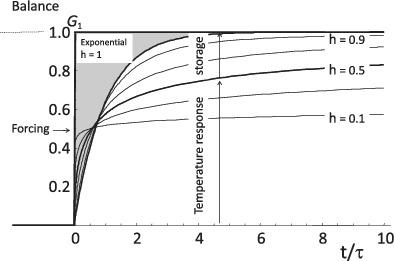当前位置:
X-MOL 学术
›
Q. J. R. Meteorol. Soc.
›
论文详情
Our official English website, www.x-mol.net, welcomes your
feedback! (Note: you will need to create a separate account there.)
The fractional energy balance equation
Quarterly Journal of the Royal Meteorological Society ( IF 3.0 ) Pub Date : 2021-02-18 , DOI: 10.1002/qj.4005 Shaun Lovejoy 1 , Roman Procyk 1 , Raphael Hébert 1, 2 , Lenin del Rio Amador 1
Quarterly Journal of the Royal Meteorological Society ( IF 3.0 ) Pub Date : 2021-02-18 , DOI: 10.1002/qj.4005 Shaun Lovejoy 1 , Roman Procyk 1 , Raphael Hébert 1, 2 , Lenin del Rio Amador 1
Affiliation

|
Classical Energy Balance Equations (EBEs) are differential equations of integer order (h = 1), here we generalize this to fractional orders: the Fractional EBE (FEBE, 0 < h ≤ 1). In the FEBE, when the Earth is perturbed by a forcing, the temperature relaxes to equilibrium via a slow power‐law process: h = 1 is the exceptional (but standard) exponential case. Our FEBE derivation is phenomenological, it complements derivations based on the classical continuum mechanics heat equation (that imply h = 1/2 for the surface temperature) and of the more general Fractional Heat Equation which allows for 0 < h < 2. Unlike some of the earlier “scale free” models based purely on scaling, the FEBE has an extra blackbody radiation term that allows for energy balance. It therefore has two scaling regimes (not one), it has the advantage of being stable to infinitesimal step‐function perturbations and it has a finite Equilibrium Climate Sensitivity. We solve the FEBE using Green's functions, whose high‐ and low‐frequency limits are power laws with a relaxation scale transition (several years). When stochastically forced, the high‐frequency parts of the internal variability are fractional Gaussian noises that can be used for monthly and seasonal forecasts; when deterministically forced, the low‐frequency response describes the consequences of anthropogenic forcing, it has been used for climate projections. The FEBE introduces complex climate sensitivities that are convenient for handling periodic (especially annual) forcing. The FEBE obeys Newton's law of cooling, but the heat flux crossing a surface nonetheless depends on the fractional time derivative of the temperature. The FEBE's ratio of transient to equilibrium climate sensitivity is compatible with GCM estimates. A simple ramp forcing model of the industrial‐epoch warming combining deterministic (external) with stochastic (internal) forcing is statistically validated against centennial‐scale temperature series.
中文翻译:

分数能量平衡方程
经典能量平衡方程(预算外开支)是整数的顺序(微分方程ħ = 1),在这里,我们概括这对分数阶:分数EBE(FEBE,0 < ħ ≤1)。在FEBE中,当地球受到强迫干扰时,温度会通过缓慢的幂律过程松弛到平衡:h = 1是例外(但标准)的指数情况。我们的FEBE推导是现象学的,它是对基于经典连续介质力学热方程(隐含h = 1/2的表面温度)和更通用的分数热方程的推导的补充,该方程允许0 < h <2.与一些早期的纯粹基于缩放的“无标度”模型不同,FEBE具有额外的黑体辐射项,可以实现能量平衡。因此,它具有两个缩放比例机制(不是一个),它具有对极小的阶跃函数扰动稳定的优势,并且具有有限的平衡气候敏感性。我们使用格林函数求解FEBE,格林函数的高频和低频限制是具有松弛标度过渡(数年)的幂定律。当被随机地强迫时,内部可变性的高频部分是分数高斯噪声,可以用于月度和季节预报;当确定性地强迫时,低频响应描述了人为强迫的后果,它已用于气候预测。FEBE引入了复杂的气候敏感性,方便处理周期性(尤其是年度)强迫。FEBE遵守牛顿冷却定律,但穿过表面的热通量仍取决于温度的分数时间导数。FEBE的瞬态与平衡气候敏感度之比与GCM估计值兼容。根据百年尺度的温度序列,通过统计验证了一个简单的工业时代变暖的强迫强迫模型,该模型将确定性(外部)强迫与随机(内部)强迫相结合。瞬态与平衡气候敏感性之比与GCM估计值相符。根据百年尺度的温度序列,通过统计验证了一个简单的工业时代变暖的强迫强迫模型,该模型将确定性(外部)强迫与随机(内部)强迫相结合。瞬态与平衡气候敏感性之比与GCM估计值相符。根据百年尺度的温度序列,通过统计验证了一个简单的工业时代变暖的强迫强迫模型,该模型将确定性(外部)强迫与随机(内部)强迫相结合。
更新日期:2021-02-18
中文翻译:

分数能量平衡方程
经典能量平衡方程(预算外开支)是整数的顺序(微分方程ħ = 1),在这里,我们概括这对分数阶:分数EBE(FEBE,0 < ħ ≤1)。在FEBE中,当地球受到强迫干扰时,温度会通过缓慢的幂律过程松弛到平衡:h = 1是例外(但标准)的指数情况。我们的FEBE推导是现象学的,它是对基于经典连续介质力学热方程(隐含h = 1/2的表面温度)和更通用的分数热方程的推导的补充,该方程允许0 < h <2.与一些早期的纯粹基于缩放的“无标度”模型不同,FEBE具有额外的黑体辐射项,可以实现能量平衡。因此,它具有两个缩放比例机制(不是一个),它具有对极小的阶跃函数扰动稳定的优势,并且具有有限的平衡气候敏感性。我们使用格林函数求解FEBE,格林函数的高频和低频限制是具有松弛标度过渡(数年)的幂定律。当被随机地强迫时,内部可变性的高频部分是分数高斯噪声,可以用于月度和季节预报;当确定性地强迫时,低频响应描述了人为强迫的后果,它已用于气候预测。FEBE引入了复杂的气候敏感性,方便处理周期性(尤其是年度)强迫。FEBE遵守牛顿冷却定律,但穿过表面的热通量仍取决于温度的分数时间导数。FEBE的瞬态与平衡气候敏感度之比与GCM估计值兼容。根据百年尺度的温度序列,通过统计验证了一个简单的工业时代变暖的强迫强迫模型,该模型将确定性(外部)强迫与随机(内部)强迫相结合。瞬态与平衡气候敏感性之比与GCM估计值相符。根据百年尺度的温度序列,通过统计验证了一个简单的工业时代变暖的强迫强迫模型,该模型将确定性(外部)强迫与随机(内部)强迫相结合。瞬态与平衡气候敏感性之比与GCM估计值相符。根据百年尺度的温度序列,通过统计验证了一个简单的工业时代变暖的强迫强迫模型,该模型将确定性(外部)强迫与随机(内部)强迫相结合。











































 京公网安备 11010802027423号
京公网安备 11010802027423号